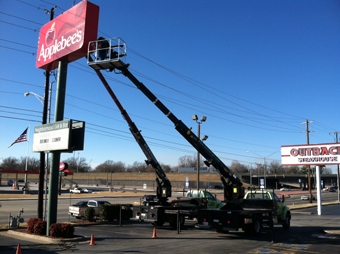A bucket truck is one of the essential tools utilized for up-in-the-air sign installations. But it’s important that these vehicles are used properly—both for the equipment itself and the personnel working in it. Bryan Wilkerson, vice president of manufacturer Wilkie Mfg., LLC, offers these five golden tips to ensure safety when operation and/or working in a bucket truck:
#1. Always wear your body harness and belt off to an approved anchor point any time that you are elevated off the ground. And follow the OSHA guidelines as laid out in OHSA 29 Code of Federal Regulations, Subpart M, Fall Protection, 1926.500, 1926.501, 1926.502, and 1926.503.
#2. Watch for overhead power lines and in the work area before you begin work. The proper clearance for working around power lines is laid out in OSHA sections:
• 1926.550(a)(15) Except where electrical distribution and transmission lines have been deenergized and visibly grounded at point of work or where insulating barriers, not a part of or an attachment to the equipment or machinery, have been erected to prevent physical contact with the lines, equipment or machines shall be operated proximate to power lines only in accordance with the following: 550(a)(15)(i);(ii);(iii);(iv);(v);(vi);(vii).
• 1926.550(a)(15)(i) For lines rated 50kV. or below, minimum clearance between the lines and any part of the crane or load shall be 10 feet.
• 1926.550(a)(15)(ii) For lines rated over 50 kV., minimum clearance between the lines and any part of the crane or load shall be 10 feet plus 0.4 inch for each 1 kV. over 50 kV., or twice the length of the line insulator, but never less than 10 feet.
• 1926.550(a)(15)(iv) A person shall be designated to observe clearance of the equipment and give timely warning for all operations where it is difficult for the operator to maintain the desired clearance by visual means.
• 1926.550(a)(15)(vi) Any overhead wire shall be considered to be an energized line unless and until the person owning such line or the electrical utility authorities indicate that it is not an energized line and has been visibly grounded.
• 1926.550(a)(15)(vii)(c) Combustible and flammable materials shall be removed from the immediate area prior to operations.
#3. Make sure the equipment that you will be working on is adequately stabilized. This could include stabilizer pads, wheel chocks, outriggers, or other devices as required by the manufacture of your lift.
#4. Mark your work area properly not only for you and your crew’s safety (such as preventing vehicles in the work area) but also other persons in the area from falling objects, trip hazards or other dangers.
#5. Be familiar with the equipment that you are working with and fallow the manufactures recommendations in operation and maintenance. These will be put forward in the operations manual, which every piece of equipment is required to have on the job site.
More installation coverage can be found in the July 2014 issue of Sign Builder Illustrated.










